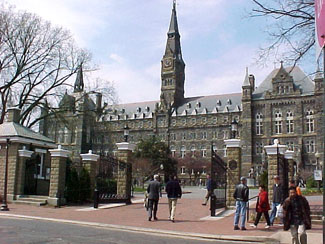| Home | Blog | Ask This | Showcase | Commentary | Comments | About Us | Contributors | Contact Us |

New GI Bill is expected to draw hundreds of thousands of veterans to college this fallASK THIS | July 183, 2009Aug. 1 is implementation date; reporters can track progress in their states. Benefits may be uneven from state to state—because of a quirk, for example, California private colleges are less likely to participate. By Alexa Millinger The Aug. 1 implementation date for the new, Post-9/11 GI Bill is fast approaching. Reporters can track how colleges and veterans in their state are responding to gauge the bill’s success in advancing higher education for veterans. Experts expect the new bill, which was passed in 2008 and marks the most significant increase in veterans’ educational benefits since the Vietnam War, to noticeably increase veteran presence on college campuses. The program covers tuition for returning veterans based on their time served and the cost of public in-state tuition. It provides a separate housing allowance and a stipend for supplies. Brian Hawthorne, D.C. Director for the advocacy group Student Veterans of America, said that as a product of the new GI Bill, many veterans have contacted his group seeking advice on taking the first steps toward enrolling in college. A number of veterans, he said, held off on entering college until the new bill took effect. The Department of Veterans Affairs has projected a 20 to 25 percent increase in participants in its academic programs, and anticipates that up to 460,000 veterans will use the Post-9/11 GI Bill in its first year. Some veterans may also opt to use the older Montgomery GI Bill or another of the VA’s education benefit programs, which may pay out more benefits depending on the veteran’s situation. “The new GI Bill is great for vets and all that, but it’s also a message from the government that says, ‘Not only do we want our vets in school, but we want to make them go to school’,” Hawthorne said. The program’s preliminary enrollment numbers will not be available from the VA until the implementation date, but reporters across the country can check in with their state’s universities to track whether the number of veterans is increasing, as well as how universities are adjusting to accommodate veterans. In recent years, veterans groups have increased calls for universities to ramp up their support services for veterans who find it difficult to adjust to campus life. The Post- 9/11 GI Bill aims to increase affordability for veterans at private institutions as well. The Yellow Ribbon Program is a provision of the new bill in which universities agree to help supplement the remainder of tuition exceeding that covered by the GI Bill. Nearly 700 colleges voluntarily signed on to the program before its mid-June sign-on deadline. In agreeing to the Yellow Ribbon Program, colleges enter into a dollar-for-dollar matching agreement with the federal government, and can select what portion of the remainder they will fund. Colleges in some areas of the country were left with more of a burden than others with regard to the Yellow Ribbon Program. California’s private colleges were less apt to participate since, due to the bill’s wording , veterans attending private colleges in California are left without any tuition benefits from the VA. As a Los Angeles Times article pointed out, the bill covers tuition up to the maximum in-state public school level. But California schools have long referred to tuition as “fees,” not “tuition” – a semantic quirk that leaves California’s private universities with substantially more to fund if they choose to help subsidize veterans’ tuition. Nonetheless, a number of California private schools – including Stanford – did opt to make some level of contribution. Washington, D.C. is also put at a disadvantage since the District’s only public university, the University of the District of Columbia, has one of the lowest tuition costs in the country. Therefore veterans who choose to attend D.C.’s private schools are left with a substantial bill to pay. But some of the city’s priciest schools – Georgetown and George Washington University – have pledged more than $2 million and $2.5 million respectively toward veterans’ tuition costs in the coming year. John Schupp, a chemistry professor at Cleveland State University in Ohio, is working to convince universities that it is in their best interest to actively recruit veterans. The spending stipend that veterans are given under the GI Bill as a boost to the local economy, he says, is just one way that a veteran community on campus can benefit a school. But the school, he believes, should support the veteran in return. Influenced by the plight of a female student who had returned from duty in Kosovo and motivated by the low college graduation rates among veterans, he created a program called Supportive Education for the Returning Veteran – or SERV – to help veterans realize their strengths and succeed on campus. “If a person is over there busting down the door in Baghdad, he should be able to handle English 101,” Schupp said.
|


